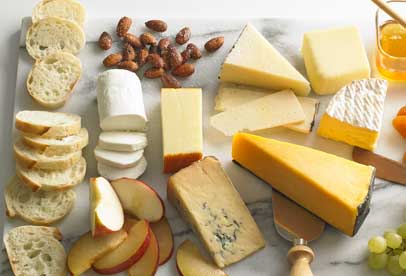
15 Best Heart-Healthy Foods
Eating for a healthy heart means filling your plate with heart-healthy foods like fruits and vegetables, paying attention to fiber, eating fish a couple times a week, eating healthy fats and limiting unhealthy fats like trans fats, as well as salt. And although no single food is a cure-all, certain foods have been shown to improve your heart health. Find out how these 15 foods may help lower your risk of heart disease.
1. Yogurt
Research shows yogurt may protect against gum disease. Left unchecked, gum disease may elevate a person′s risk for heart disease. Researchers from Japan analyzed dietary intakes from nearly 1,000 adults and found those who consumed the highest levels of dairy′specifically yogurt and yogurt-type drinks?had the healthiest gums. Their report, published in the Journal of Periodontology, credits probiotics (a.k.a. ?good bacteria?) as one possible champion of gum health. Experts believe that probiotics may help to counter growth of the ?unfriendly? bacteria in the mouth. Probiotics are live active cultures used to ferment foods, such as yogurt and kefir (fermented milk), and studies suggest that they may improve digestion and boost immunity too. As for gum health, it′s not yet clear how much yogurt (or other fermented dairy foods) one needs to consume to reap the benefits, says Yoshihiro Shimazaki, D.D.S., Ph.D., of Kyushu University, the study′s lead author.
2. Raisins
Research has shown that antioxidants in raisins fight the growth of a type of bacteria that can cause inflammation and gum disease. People with gum disease?which affects up to 50 percent of American adults?are twice as likely to suffer from heart problems. So, dealing with one can help people avoid the other. Last summer, a major heart journal and a major periodontal journal simultaneously published a consensus paper that outlines the link between the two diseases: inflammation. As a result, choosing certain foods, such as raisins, may help you protect both your gums and your heart.
3. Whole Grains
People who eat plenty of whole grains tend to be leaner and have a lower risk of heart disease than those who don′t. This is probably because whole grains contain antioxidants, phytoestrogens and phytosterols that are protective against coronary disease.
The fiber in whole grains also has its benefits: various studies link a high-fiber diet with a lower risk of heart disease. In a Harvard study of female health professionals, people who ate a high-fiber diet had a 40 percent lower risk of heart disease than those who ate a low-fiber diet.
Aim to include plenty of foods that are rich in soluble fiber, which, studies show, can help lower ?bad? LDL. Soluble fiber binds bile acid, a key component in fat digestion that our bodies make from cholesterol. We can′t digest fiber, so when bile acids are bound to it, they get ushered out of the body as waste. This causes the body to convert more cholesterol into bile acids, which ultimately has the effect of lowering circulating cholesterol levels. Foods high in soluble fiber include oatmeal, barley, beans, okra and eggplant, and citrus fruit, such as oranges.
4. Beans
Eating beans regularly is good for your heart, and you don′t need to eat a lot of them to benefit. A study published in the Journal of Nutrition suggests having just 1/2 cup of cooked pinto beans daily might lower cholesterol. Soluble fiber is a key reason why, says Philip Ades, M.D., author of the EatingWell for a Healthy Heart Cookbook (The Countryman Press, 2008). ?Like all foods that contain a lot of soluble fiber, beans help bind cholesterol and keep it from being absorbed in the gut,? he explains. And, as the fiber is fermented, it produces changes in short-chain fatty acids that can inhibit cholesterol formation. (By-products of this same fermentation process are what cause the gas so often associated with eating beans.) Other components in beans also may be responsible for the cholesterol-lowering effect. Beans contain a variety of heart-protective chemicals, including flavonoids, compounds also found in wine, berries and chocolate, that inhibit the adhesion of platelets in the blood, which can help lower risk for heart attack and strokes.
5. Salmon/Fish
Consuming two or more servings of fish per week is associated with a 30 percent lower risk of developing coronary heart disease over the long term, studies show. Fish?especially ?oily? kinds, such as salmon and tuna?contain omega-3 fats, which lower levels of triglycerides in the blood that may contribute to blood clotting. Omega-3s also lower blood pressure slightly and can help prevent irregular heart rhythms. No common fish delivers more of the omega-3 fatty acids than salmon. Flaxseed oil, canola oil and walnuts also contain omega-3 fats.
6. Nuts Nuts are chock-full of vitamins, minerals, heart-healthy monounsaturated fats and low levels of saturated fats. Research suggests that people who eat nuts?walnuts, pecans, almonds, hazelnuts, pistachios, pine nuts and peanuts (which actually are legumes)′two to four days or more per week have a lower incidence of heart disease than people who eat them less often.
7. Chocolate
Researchers have discovered that eating moderate amounts of flavanol-rich dark chocolate has a blood-thinning effect, which can benefit cardiovascular health, and it may also boost the immune system by reducing inflammation. The Kuna people of the San Blas islands, off the coast of Panama, have a rate of heart disease that is nine times less than that of mainland Panamanians. The reason? The Kuna drink plenty of a beverage made with generous proportions of cocoa, which is unusually rich in flavanols that help preserve the healthy function of blood vessels. Maintaining youthful blood vessels lowers risk of high blood pressure, type 2 diabetes, kidney disease and dementia.
Some research also suggests cocoa may help lower blood pressure. It appears that a compound in cocoa, called epicatechin, boosts nitric oxide, a substance that has been shown to be crucial to healthy blood vessels. Plentiful levels of nitric oxide help keep blood pressure from climbing. Be sure to choose dark chocolate, ideally one that′s 70 percent cocoa solids; milk chocolate lacks significant levels of epicatechin.
8. Tomatoes
An excellent source of vitamin C, plus vitamin A, potassium and fiber, tomatoes are high in lycopene, which works with other vitamins and minerals to aid in disease prevention. Research suggests that the combination of nutrients in tomatoes may help prevent cardiovascular disease. Cooking may actually increase the health benefits of this lush fruit because although cooked tomatoes have less vitamin C, their lycopene is more available and antioxidant activity is undiminished by cooking.
9. Apples
Apples were associated with a lower risk of death from both coronary heart disease and cardiovascular disease in the Iowa Women′s Health Study, which has been tracking 34,000-plus women for nearly 20 years. Finnish researchers studying dietary data collected over 28 years from 9,208 men and women found that frequent apple eaters had the lowest risk of suffering strokes compared with nonapple eaters. What explains the hearty benefits? Researchers suggest that the strong antioxidant flavonoid compounds found in apples?quercetin, epicatechin, epigallocatechin, kaempferol and other polysyllabic wonders?play a key role by preventing ?bad? LDL cholesterol from oxidizing and triggering a series of events that result in the buildup of plaque in arteries, as well as inhibiting inflammation. Apples are also rich in pectin, a form of soluble fiber known to help lower cholesterol, and they provide a decent amount of vitamin C, another antioxidant.
10. Berries
Eating just under a cup of mixed berries daily for eight weeks was associated with increased levels of ?good? HDL cholesterol and lowered blood pressure, two positives when it comes to heart health, according to a study of 72 middle-age people published recently in the American Journal of Clinical Nutrition. Included in the mix were strawberries, red raspberries and bilberries′similar to blueberries?as well as other berries more common in Finland (where the research was conducted): black currants, lingonberries and chokeberries. The diverse range of polyphenols?a broad class of health-promoting plant compounds that includes anthocyanins and ellagic acid?provided by the mix of berries is likely responsible for the observed benefits. Polyphenols may increase levels of nitric oxide, a molecule that produces a number of heart-healthy effects. One is helping to relax blood vessels, which subsequently results in lowered blood pressure.
11. Pomegranates
Studies have shown that the fruit may help to reduce the buildup of plaque in arteries and lower blood pressure. Experts believe that pomegranate′s benefits come from its powerful punch of polyphenols?including anthocyanins (found in blue, purple and deep-red foods) and tannins (also found in wine and tea). In a 2008 study, researchers found that compared with other antioxidant-rich beverages including blueberry juice, cranberry juice and red wine, ?pomegranate [juice] naturally has the highest antioxidant capacity,? reports David Heber, M.D. Ph.D., study collaborator and director of the UCLA Center for Human Nutrition.
12. Bananas
One banana has 422 mg?about 12 percent of your recommended daily dose?of potassium. The potassium in bananas helps maintain normal heart function and the balance of sodium and water in the body. Potassium helps the kidneys excrete excess sodium, thereby contributing to healthy blood pressure. This mineral is especially important for people taking diuretics for heart disease, which combat sodium and water retention but also strip potassium from the body in the process. Other good sources include sweet potatoes (694 mg for one medium), nonfat yogurt (579 mg for 1 cup) and spinach (419 mg for 1/2 cup, cooked).
13. Popcorn
Popcorn delivers polyphenols?antioxidants linked to improving heart health. Gram for gram, popcorn boasts three times more polyphenols than kidney beans (the highest vegetable polyphenol source) and four times more than cranberries (the best fruit source), according to recent research out of the University of Scranton. What′s more, popcorn is a whole grain?and people who eat plenty of whole grains tend to be leaner and have a lower risk of heart disease than those who don′t.
14. Green Tea
Some of the strongest evidence of tea′s health benefits comes from studies of heart disease. Scientists have found that those who drink 12 ounces or more of tea a day are about half as likely to have a heart attack as nontea drinkers.
Scientists also reported in 2009 that Japanese men who drank a daily cup of green tea significantly lowered their risk of developing gum disease′the more tea, the lower the risk. The researchers believe antioxidants called catechins in green tea are the key. Catechins hamper the body′s inflammatory response to the bacteria that cause gum disease. People with gum disease are twice as likely to suffer from heart problems.
15. Wine/Alcohol
Scientific literature indicates that people who drink moderately are less likely to have heart disease than those who abstain. Drinking in moderation may protect the heart by raising ?good? HDL cholesterol, decreasing inflammation and ′thinning the blood? (preventing clots that can cause heart attack and stroke). Moderate drinking also increases estrogen, which protects the heart?a benefit particularly helpful to postmenopausal women whose reduced estrogen levels increase their risk of heart disease. Remember, 1 drink equals 12 ounces of beer, 5 ounces of wine or 1.5 ounces of liquor.
Related News

Weight-lifting and protein shakes rich in growth hormones may make you bald

Natural Herbal Gummies

Working It Out: The future of work and digital

How mood and eating behaviour are connected

5 Reasons Cheese is Actually Good For Your Health

Scientists found effective dandruff treatment

Five foods that can cause problems if consumed on an empty stomach!

15 Best Heart-Healthy Foods
Most Read
★Healthy eating
★23 foods that contain NO calories
★Top Natural Body Care Tips for Women
★7 Healthy Hacks for Your Pumpkin Spice Latte
★3 Must Try Face Yoga Exercises For Glowing Face
★Can high heels give you cancer?
★10 Ways To Use Sesame Oil For Beautiful Skin
★8 Best Foods to Eat for Weight Loss
★7 Filling Foods to Keep Belly Fat at Bay
★6 Best Oils for a Naturally Clear and Glowing Skin
★Why You Need to Start Combining Avocados and Peaches
★Why You Probably Shouldnt Take Diet Advice from Your CrossFit Coach
★5 Effective Baba Ramdev Yoga Asanas To Increase Height
★Five-second rule for food dropped on the floor approved by germ scientists
★Study reveals alarming dangers of anti-ageing jabs
★Top Fitness Stars Share Their Most Common Workout Habits
★Research reveals surprising health benefits of chewing your food
★5 surprising beauty benefits of amla
★Yoga Poses for People with Less Flexible Body
★Cancer warning over skin bleaching treatment
★Haryana girl Nishtha Dudeja wins Miss Deaf Asia 2018 crown
★How your make-up bag could wreck your health
★5 foods for healthy skin
★10 Healthy Twists on Classic Diner Dishes
★Guinness World Record for bearded woman Harnaam Kaur
★How to Do Face Cleansing at Home?
★4 Totally avoidable gym mistakes
★Top Foods for Calcium and Vitamin D
★Daylight Savings Time: That miserable time of year when many mourn loss of one-hour sleep
★Fasting might be good for your healh, research says
★10 Benefits Of Climbing Stairs ? An Underdog In The World Of Fitness
★Exercise can help boost memory through bone hormone: Study
★Plum goodness for your hair!
★The Brilliant Food Combo That Helps You Burn More Fat
★The Simple 20-Minute Habit That Could Save Your Life
★Does ginger gene offer key to younger looking skin?
★The best effective and natural plants for a good memory
★Natural Herbal Gummies
★Brain health food guide for older adults
★5 Hot Yoga Poses For Rapid Weight Loss
★11 Realistic Methods of Stress Management
★5 superfoods to combat hair loss
★Top 10 Diet and Fitness Tips for Men
★Best foods for healthy skin
★Surgery addict rushed to hospital after his body REJECTED his new nose
★Legumes, nuts and kale can help you get big muscles
★Take care of your coloured hair with Wella
★Whole-body vibration may be as effective as regular exercise
★5 Ways to Dry Herbs
★6 Foods You Can Incorporate In Your Fat Burner Diet For Best Results
